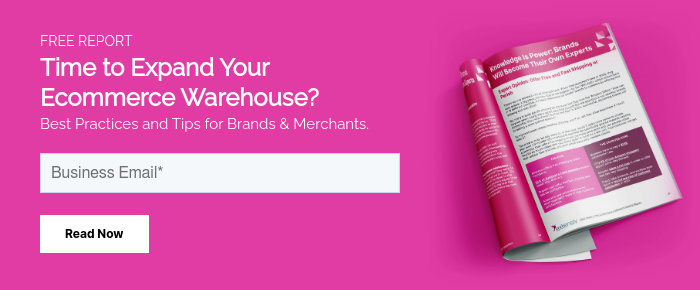Online merchants have to be good at selling and marketing. Indeed, it’s only once you’ve nailed the marketing side of things that you can start selling to the right people.
A key part of online marketing is SEO.
SEO (Search engine optimization) is the process of making your eCommerce store’s web pages easy to find by search engines organic results, such as Google. It increases the traffic to your website the higher it ranks.
In fact, as of April 2019 the average CTR for results on desktop in the first ranking position was 31.19 %. Compare this to further down the SERPs on position 11, which has a CTR of 1.07%. This is a large decline in traffic.
While SEO can be a complex process that takes time, for a lot of smaller brands it is the more viable option if they don’t have the marketing budget in place for larger or multiple campaigns.
For mid-size to enterprise-level businesses who want to tie together in-store sales with online marketing, gain higher click through rates and increase their brand recognition, comprehensive SEO plans can provide exactly that.
The right SEO strategy will help you go above and beyond what your competitors are achieving by gaining targeted traffic — meaning visitors who are likely to buy the products for sale in your store.
And with research suggesting 94% of web users are clicking on natural listings rather than paid, choosing the right SEO strategy seems to be more beneficial to your store’s bottom line.
In this article, we cover all the bases of what online sellers need to do to rank with no ad spend.
The Old Moat and the New Moat
The way commerce has evolved over the last 15-20 years has drastically changed how consumers shop.
The old moats were focused on:
- Economies of scale: Huge structural advantages in their business model
- Network effects: The value of a product increases directly as a function of how many others use it
- IP/Patents, trade secrets, license relationships: Prevented competitors from copying them or allowed to charge a premium
- High switching costs: Make it inconvenient or expensive to change from one product to another
- Customer Satisfaction: Keep customers from ever wanting to leave
If brands continue to only focus on the old methods and don’t innovate and implement the current and upcoming digital technologies, they will get left behind and increase their likelihood of business failure.
Fast forward to 2019, and the new moats now position themselves as the go-to brand — the authority in their niche. Customer satisfaction has also now evolved into building relationships with customers.
The new moats are focused on:
- Platform: Make it the norm for people to view your brand as the authority. They go to you for the expert content
- Community audience: Brands don’t build communities. People do. Communities form around meaning and shared ideas
- Brand: A crisp identity that's relevant and resonates with your customer
To do this, you first need a brand. This means creating the kind of valuable, in-depth and educational content that resonates with your target audience.
For example, online sellers are now creating in-depth product guides, how-to articles and comparison articles that answer customer objections and build trust. This leads to increasing customer engagement and repeated sales.
It is also a good idea for sellers to think outside the box when producing content. Think beyond simply selling your product. You want your website to become the ultimate resource that shoppers turn to when they want to know anything about your niche.
Below is a blog post that Extensiv (formerly Skubana) published on our blog about the best practices to create the perfect purchase order template.
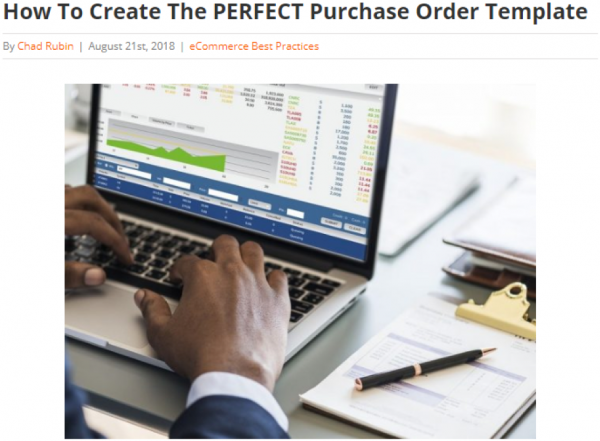
Online sellers are also leveraging the remarkable power of social media to create online communities where they can encourage user-generated content, such as customer reviews, social media posts, images, blog posts, videos, podcasts and testimonials.
In 2019, customers look for brands that have values that they share and that have an identity they can relate to. A survey showed the most important attributes of a company that affected buying decisions where:
- Environmentally-friendly business practices (71%)
- Social responsibility (68%)
- Giving back to the local community (68%)
- Price (44%)
Meanwhile, both customers and Google want a brand to demonstrate their value and expertise in the form of content. When you do this, you’re onto a winner.
Difference Between Outbound and Inbound Marketing
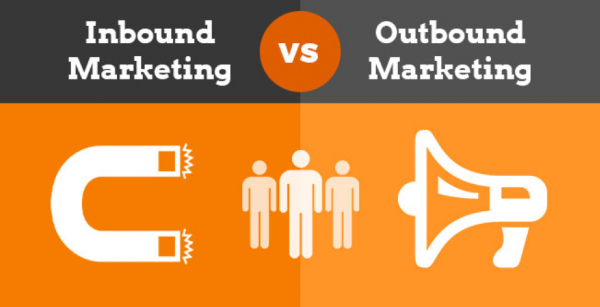
Inbound marketing helps people find your brand through its channels, such as blogging and Social media. It helps “pull” customers towards you. Outbound marketing involves “pushing” a message out far and hoping it sticks. It is paying an external channel to have your message placed in front of your target customers. This form of marketing is getting less and less effective over time.
For example, Google pay-per-click (PPC) advertising is a form of outbound marketing that, while it can definitely generate leads, and can cost your ecommerce business a lot of money. It’s the same with social media marketing. It can really drain your wallet and results aren’t guaranteed.
Other forms of outbound marketing are:
- Display Ads
- Email to purchased lists
- Trade shows
- Cold calling
- Print/OOH (Out-of-Home)/Radio
Inbound marketing, on the other hand, is a form of digital real estate you own. It’s focused on getting found by customers (as opposed to you chasing after customers) on the back of the awesome content you’ve created.
Take a blog, for example. If you’re using your blog to produce amazing content that adds value to people’s lives and solves their problems better than anyone else, your content will generate more links and shares, and Google will rank you higher.
Other examples of inbound marketing include:
- eBooks
- Podcasts
- Videos
- SEO
- Referred traffic
- Joint venture webinars
- Magazines
- Email newsletters
- Earned social media
For inbound marketing to work really well, you have to make sure everything you produce offers a ton of value.
How to Win In This New Model With Inbound Marketing Strategies
To win at this new model, you need to go where your customers are. Then, you can frame your message so it hits the spot.
This means producing the right content on the right channels. Focusing more on inbound marketing and not outbound marketing.
To this end, you need to understand your target audience - why do they shop, how do they look for information, and where do they interact with content. Find where the majority of your customers are coming from:
- Amazon
- Social Media
- Voice Search
Check your analytics to learn more about your target audience by delving into the available data. You can use the Acquisition Overview on Google Analytics to evaluate which channels are bringing you the most visitors.

Wherever your customers are, and whatever devices they use the most, it’s important that you optimize your content for each channel.
It’s all about understanding three things:
- Your brand
- Your audience
- Platforms
Understanding your brand means understanding your core message. This core message acts as the glue that keeps your content distribution cohesive. What ties channels together seamlessly is your core message. As a result, the balance between different channels is seamless and easy for your audience to digest.
For example, Away, a luggage company, produces podcasts around the theme of travel to raise their visibility with consumers.

The same goes for Cotopaxi. They have also created the Questival race that allows teams of 2-6 friends to win up to $6000 in prizes by competing in challenges in their city. This provides their customers with a much more personalized experience with the brand.
They then write about the race on their website, involving even more customers. This helps develop customer relationships.
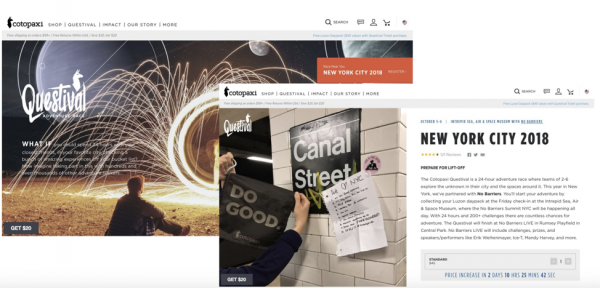
Don’t merely think about the channels your audience wants to see you on. Think about the devices they use the most. Voice search is going hand in hand with the mobile revolution, and ecommerce store owners need to start optimizing their store for voice search.
This is just one example, however, and you will need to dial in the accessibility of your store for all channels.
Renting the Channel
When ecommerce store owners use PPC Ads and Facebook Ads to increase sales, they are temporarily renting the channels. They do not own them.
Even though these tactics are typically not the best fit for a larger marketing plan, some companies do implement them. This is often because paid search dominates above-the-fold content.
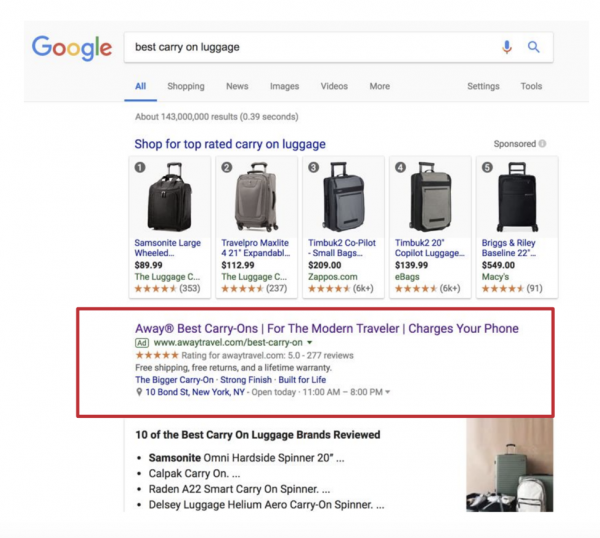

However the costs of running these campaigns can run high, especially if the person managing the ads is not an experienced PPC and Facebook Ads account manager.
This is why many store owners prefer to own the channel rather than rent it.
Owning the Channel
People who type in a search query into Google are looking for specific information.
And if they type in your products, it means they’re in the mood to buy. If you can satisfy their queries and produce the right content that hits the spot, you can turbocharge your rankings and turn leads into conversions. To do that, you need to put a strategy into place. Your SEO strategy.
And you need to nail your SEO and implement Search engine optimization, so you rank super well on Google.
That’s a given, and it’s what we’re going to focus on for the rest of this article. Why? Because organic traffic from Google is going to be key to your success.
SEO is the gift that keeps on giving.
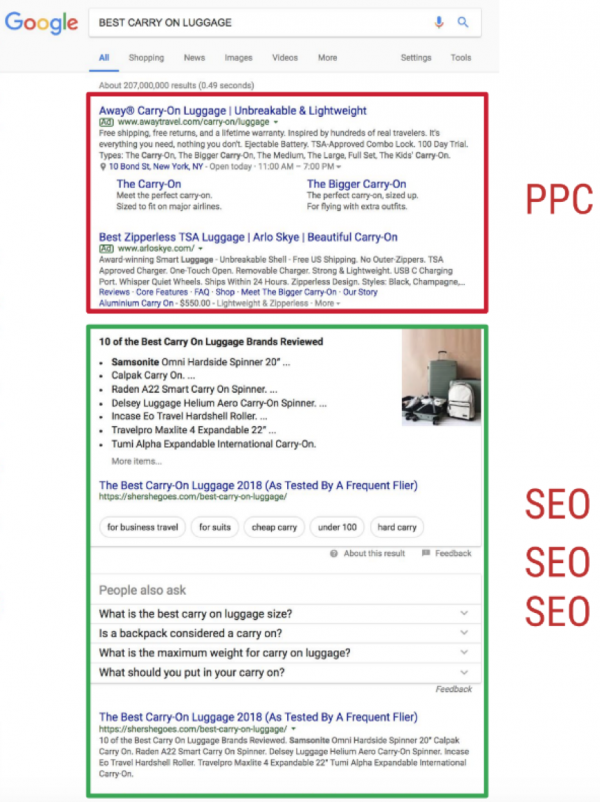
Ecommerce SEO Strategy
To win the ecommerce war on Google you need to put together a solid, flawless white-hat SEO strategy. Here’s how to do that:
Site Speed
Why Site Speed So Important to Google SEO
Google rewards websites that offer the best user experience possible to its audience. The key to a good user experience is site speed, so much so that Google expanded how it affects your ranking.

If a website takes too long to load, the user will bail out. Slow site speed is essentially the first thing a user will notice. Good site speed, then, boosts visibility and usability.
Here are a few ways to boost your site speed:
Site Speed Audit and Analysis
To perform a site speed audit and analysis, you can use a tool called GTmetrix. This tool gives you insight into the inner workings of your website so you know what’s slowing it down. It will show your pages load time, the total number of requests, as well as total page size.
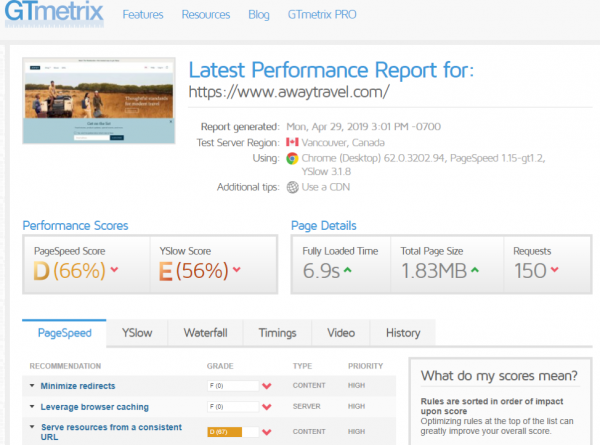
The total number of requests is important. 150 requests are way too high, 25-50 requests is the ideal ball park.
You can also compare your website’s performance to the average of all sites are analyzed by GTmetrix. For example, each website is given a grade that reflects its performance. Away Travel scored E.
Below you can see the site performance of other top brands.
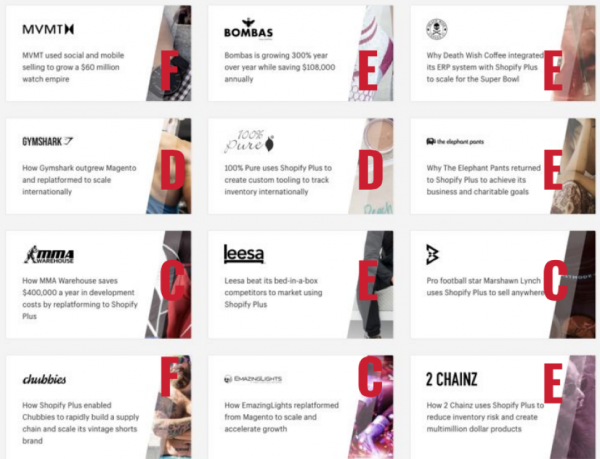
The Waterfall Chart displays the request-by-request loading behavior of your website, as seen for my ThinkCrucial website below.
The four highlighted items are the scripts for the apps that load first on the ThinkCrucial website. These apps could be slowing down the load speed of ThinkCrucial's website when visitors first land on it.
These apps could be delayed from starting, which will increase the load speed of my website.
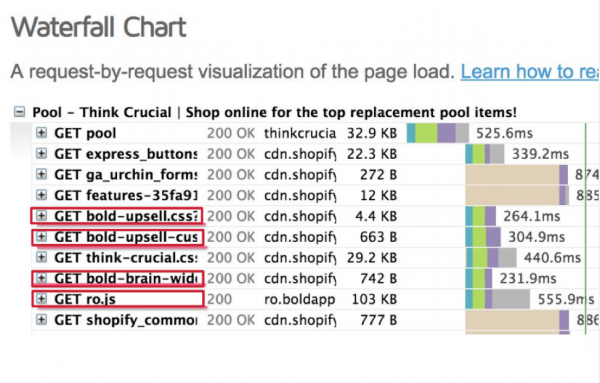
This data will aid you in debugging performance issues and site speed issues.
For your website, though, you must only audit what is necessary and important — you don't want to waste your valuable time.
Do this by making a business case for each script. Decide what's driving your business and then check what is slowing your site down.
You will then need to rewire the theme so they load after or kill the scripts.
You can also check the script load time on the Waterfall chart for my eCommerce store.
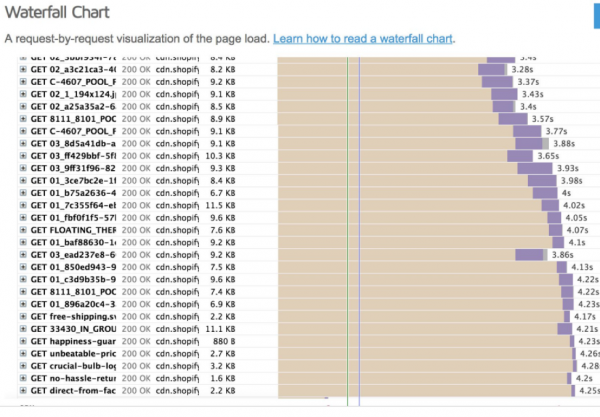
The brown you see in the chart above is known as “blocking.” Blocking is time spent waiting in the browser's queue to start the request to the server.
If there is too much brown you need to find out what is causing it and remove it.
App Audit
Shopify offers a lot of apps.
Like, a lot.
Over 8000 to be exact.
There are apps to boost your SEO, apps to help you make contact forms, and helps to help you reduce cart abandonment.
But while these apps and other UX tools handily improve the user experience and can boost conversions, they can also slow your website down.
It’s time to count your app calories by performing an app audit.
Review your current apps. How many of them do you really need? Are they all serving a productive purpose? Remove any app you don’t need, and which don’t benefit the end user right now.
To do this, first, we recommend that you take note of the apps you currently have. Below you can see how I noted the apps installed on my website and provided instructions on how to prioritize them.
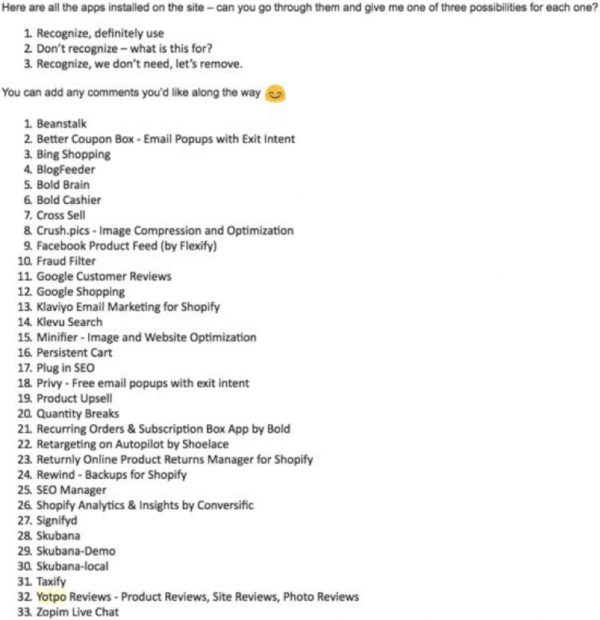
And then audit these apps by taking note of the ones you actually use.
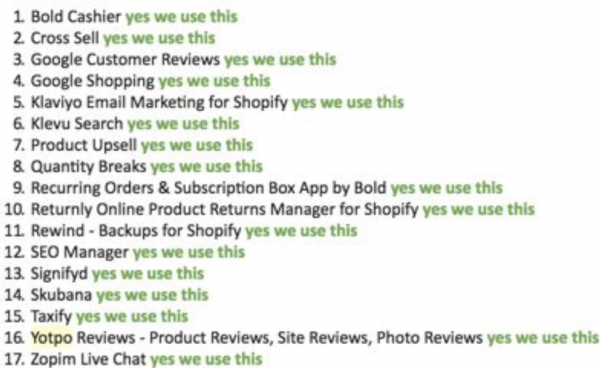
And the apps you don’t use. We found we had 11 wasteful apps.

Then go to your Shopify admin to remove the apps, it will look something like this.
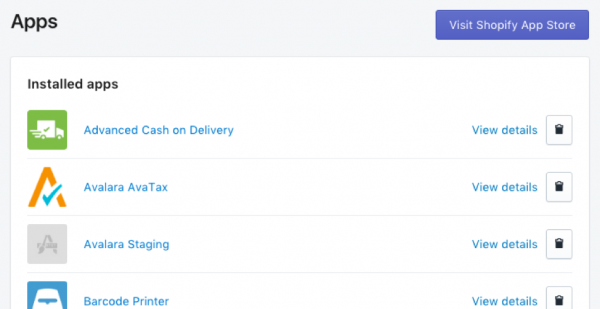
When you do remove an app, your site might still be slow because there’s some lingering code. Check your theme files to eradicate all code and trace of the app. We at Extensiv hire an experienced SEO specialist to implement these tasks. We recommend you do so too, as your website may be damaged if you change coding at the backend without any experience.
Less is more, and the average Shopify merchant has 6 apps. To make you stay lean, be careful about any app you add in the future.
It’s also a really good idea to find out what app your competitors are using. If their user experience is awesome and their website loads quickly, they’ve obviously not got apps slowing them down.
Use Shine Commerce, formerly CommerceInspector, to find out what apps they’re using to manage their email campaigns, their SEO campaigns, their upselling and cross-selling, and more.
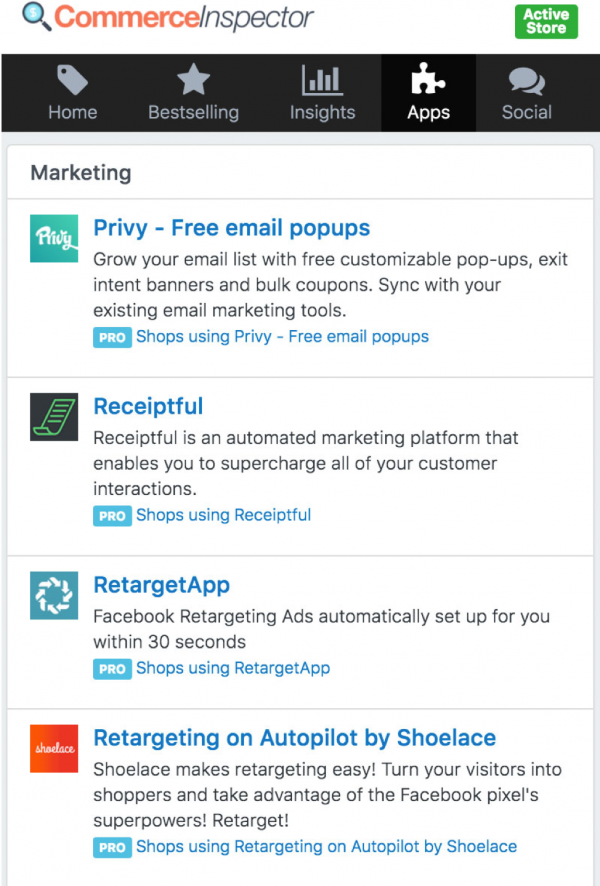
Bonus tip: you can also use Commerce Inspector to the top-selling SKUs of your competitors.
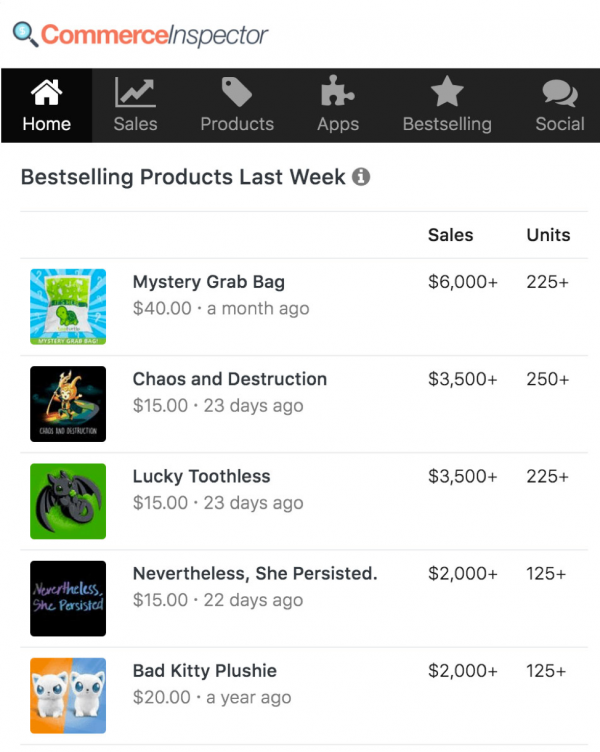
Backlinks
Backlinks are really important if you want to get traffic without spending a dime on ads. Why? Because high-quality backlinks (that is, backlinks from high domain, authoritative websites in your niche) tell Google that your website is offering value to the community. As such, Google begins to trust you more and may rank you higher.
Here are four must-use link building strategies designed to help you rank:
Benchmark Your Backlinks
To power-up your backlinks campaign, you need to measure how you stack up against your rivals.
What’s your link profile compared to theirs? You can use your SEO tool of choice to help you figure this out. If they’ve got way more authoritative and relevant backlinks than your website, it’s time to step up your game.
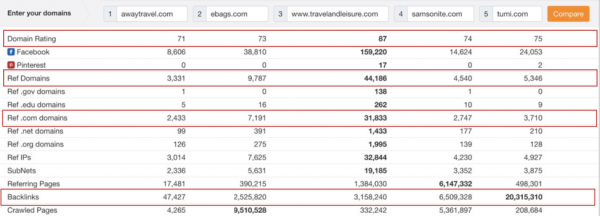
You also need to decide what’s going to be a healthy benchmark for you. In other words, what will steady growth look like in terms of the number of domains linking to you.
Reverse Engineer Your Competitor Backlinks
If your competitor has got top-quality backlinks you don’t have, don’t get jealous — get even.
In fact, don’t get even — actually overtake them by stealing their links! This is known as reverse engineering.
To reverse engineer your competitor backlinks, you need to first identify your main rivals. You can do this by searching for a keyword you’re trying to rank for.
Then, enter the first page of URLs into your SEO tool and check out their links. Most premium SEO tools allow you to do this.
Ahrefs is probably the best choice and you should sort the Backlinks list by Domain Rank.
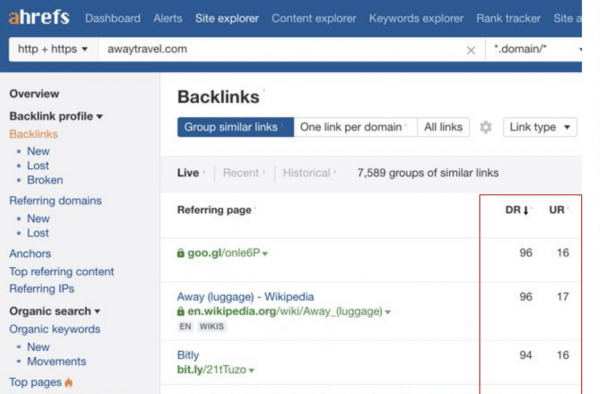
To successfully reverse engineer backlinks, you must befriend your competitor's friends. Do this by implementing the following strategies:
- Steal your competitors key influencers by reaching out to their existing mentions
- Every time your competitor gets a mention about their content, contact that person
- Build a relationship and become their friend
Keep in mind you should also be monitoring your own company’s mentions, and always ask for a link back when you see it mentioned. Do this by simply reaching out to the person who mentioned your company.
Top tip: All the people writing about your company are your friend.
Use This Simple Link Building Framework
A great way to get more high-quality (relevant) links is to produce more awesome content — for other people.
How does this work?
With guest blogging.
Guest blogging is when you find relevant, authoritative blogs in your niche who are on the lookout for content like yours. And websites always need more top quality to satisfy the demands of their audience, so it’s a win/win for both parties.
All you need to do is show them how your content will benefit them and their audience, and they should be more than happy to let you publish your articles on their blogs. And within each piece of content, there will be a backlink to your website. Bingo.
Some key criteria you could consider when choosing a prospective website for your guest blogging campaign are:
- Target: DA 20+
- Traffic: > 15k/month
- Relevancy: mostly US/regional topics are relevant
- Ahref score: DR 50+ / Moz DA 40+
- Links: Unilateral links > Bilateral links
These are only recommendations based on the criteria I use, but you can adjust this based on your company’s unique goals.
Pro Tip: Get Media Coverage for Your Business
Getting a backlink from top news and media sites is a dream of every business. So, getting media coverage for your business will be one of the most powerful ways to build authority, boost sales, and improve the rankings of your business.
Build a Backlink Machine
The best way to outrank your competitors on Google is to build a backlinks machine. A machine that you keep using again and again to achieve results.
The first part of the machine is to find qualified prospects for your guest blogging campaign using Cision Media Database.
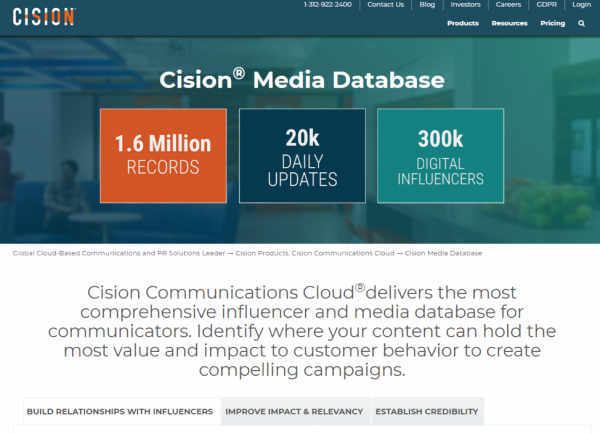
Fortunately, Cision takes a lot of the leg work out of prospecting since it has 1.6 million records of contact data for you to select from. Cision conducts serious analysis of influencers and media websites so you can trust the data will be valid. You can also find reporters for your campaign to establish a relationship independently.
Once you’ve got a list of websites, contact information and links, it’s time to reach out to them with a pitch.
We recommend you automate this process to save time. You can do this using software such as Pitchbox, which is an outreach platform.
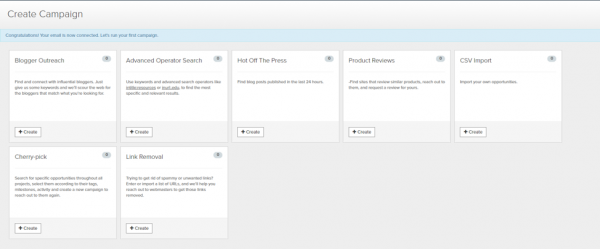
In the email you send to your prospects, write something like this:
“Hey,
I love your blog and I noticed you’ve got an article on X topic. I really like it but I felt like it was missing some crucial information your readers would really benefit from. If you’re interested, I’ve written a similar article but it has a bit more depth, data and usable information. If you’re keen to use it, let me know!”
Thanks,”
Make sure you follow up on any unanswered emails at least two times.
Pro Tip: Hire an outreach specialist
Outsourcing and delegating SEO tasks is essential. This is especially true for outreach. To hire an outreach specialist you will need to post a job.
The job description needs to be clear and concise so you can weed out any unqualified applicants.
Other tools you should consider using to help your link building campaign include:
- Moz Link Explorer: Uncover high domain authority websites and reverse engineer your competitors' backlinks effortlessly.
- BuzzStream: Simplify your email outreach efforts with practical tools and features.
- Respona: Streamline finding link-building prospects and automate outreach tasks for enhanced efficiency.
- Uppercut SEO: A leading agency offering premium services in Link Building, Content Writing, and On-Page SEO.
Content
Backlinks power-up your rankings, but it’s content that’s going to provide you with the key to you acquiring those backlinks.
Therefore you must create unbeatable content. Here’s how.
Learn What Google Wants
Google uses an artificial intelligence-powered algorithm called E-A-T, which stands for Expertise, Authority, and Trust to rank content according to how valuable it is to the reader. High-quality pages serve a noble purpose and E-A-T recognizes this.
How? A few ways. One way is how updated the content is. Another way is by checking if the content was written by qualified authors. A third way is if the website has a bad reputation.
Google, then, wants thought leader pieces. It wants you to display your expertise and authority on a particular topic. This PDF explains it all.
And it also wants to see backlinks so that it knows it can trust you.
Reverse Engineer Your Competitors
If you know who your competitors are, look at their high-traffic pages on Ahrefs. First, enter their domain name in the Ahrefs search bar then click on “Top pages.”
Here you will find all of their pages that earn them the highest traffic to their website.
Simply export all of the RD (root domains) to the specific URL and then the positions, traffic, and keywords.
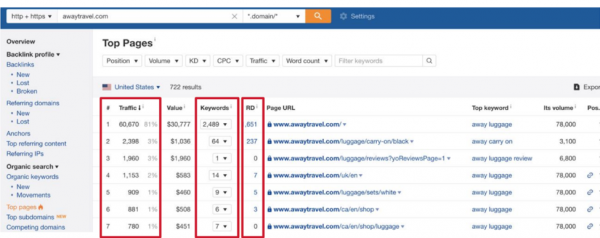
Keep in mind you want to reverse engineer your competitors highest pieces of performing content.
Take a look at their social media channels too.
Who are the key influencers talking about them? It’s your job to steal these influencers away from them so they talk about your content instead. To help you do this use a social media monitoring tool — they are like Google alerts on steroids.
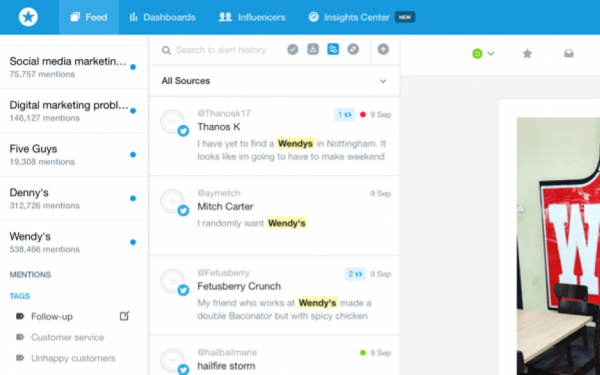
All of this information will help you decide on what type of content to create for your SEO strategy.
Fundamentals for Unbeatable Content
Long-Form In-Depth Content
Research from Backlinko has shown that long-form content performs best for SEO, with search results on Google’s front page averaging 1,890 Words.
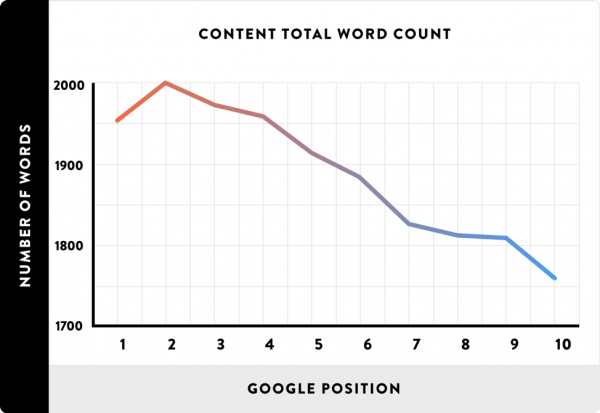
Both Google and internet users want to see more long-form content. Long-form content that is valuable, in-depth, informative, educational, and it covers all the bases on a particular topic
Type in a keyword you’re ranking for on Google and look at the first results. These are your competitors.
For example, here we have used “Digital Marketing.”
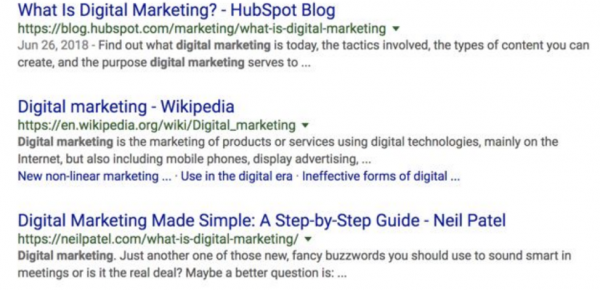
If you wanted to rank for this keyword, you would dive deep into the top results and analyze them.
What’s so great about them? Are they perhaps using a lot of case studies and data? Are there better visuals, such as infographics?
Neil Patel’s website ranks #3 for this keyword.
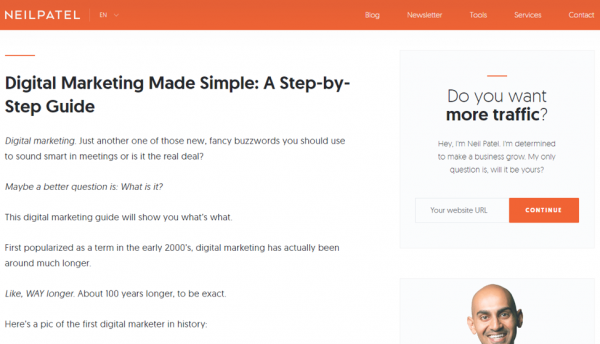
He is known for writing long posts. In fact, this post has over 3,000 words.
The content you write must be better to beat his position in the SERPs.
Engaging Content
Engaging content is fundamental. One of the reasons a rival might be ranking high in Google is because their content is unique and special. And in return visitors are staying on the page a long time.
SnackNation ranks number one in Google for the keyword healthy snacks.
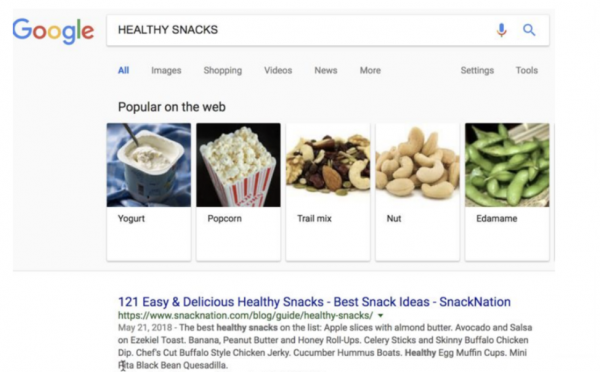
By performing a more thorough content audit, you can see the uniqueness they offer their website users.

Oh, and did we mention?
The content is also over 10,000 words long. We counted the words using the tool Web Page Word Counter tool by Wordcounter.
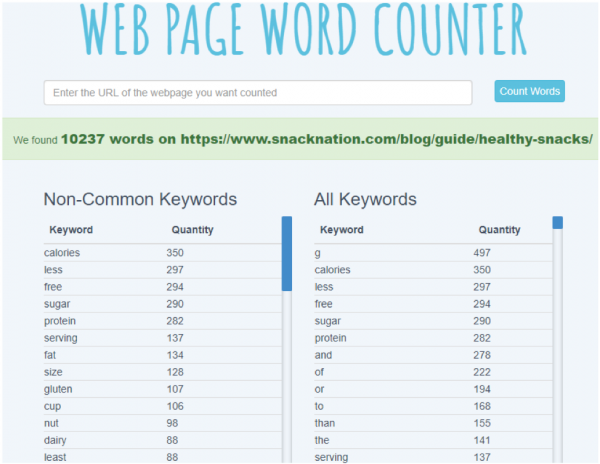
Bonus Content Upgrades
Think of ways you can create “bonus pieces” of information. This could come in the form of case studies, or it could even be a lead magnet (such as a free eBook) that offers the reader even more value.
This is known as a bonus content upgrade.
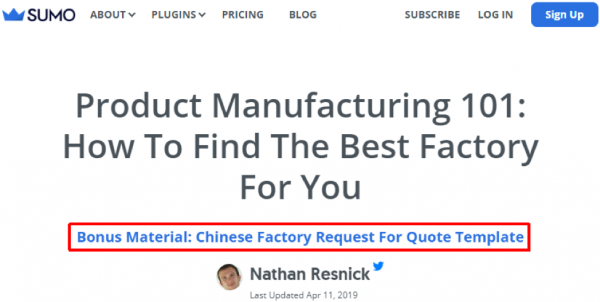
The focus at all times is on pleasing your audience. They have to get the feeling that they’re getting way more out of this than you are.
Don’t stop with just blog posts either. Produce videos, podcasts, checklists and more.
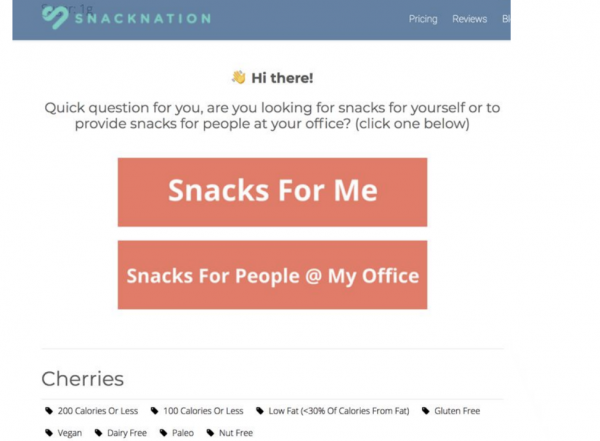
Put together a dedicated and talented content marketing team that constantly comes up with unique, valuable content that benefits the end user more than the competition.
Relevant Content and Keywords
You need to produce content and optimize it in a way that it gives people what they are looking for.
What keywords are they typing into Google? How can you satisfy their search queries?
Google can help you with this. Simply type into the Google search bar your keyword, and you will see a section called “people also ask.”
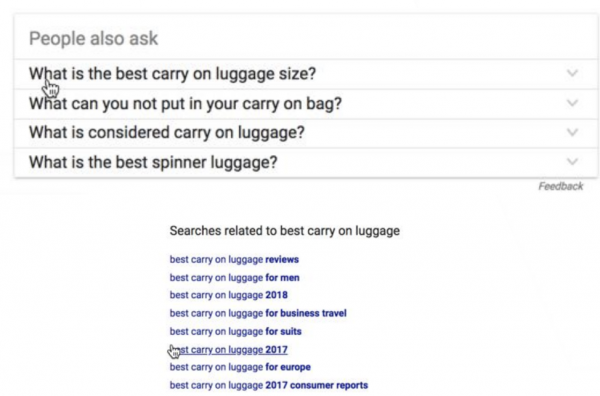
Use these questions in the pieces of content you write.
You can also generate more latent semantic indexing (LSI) keywords if needed by using software.
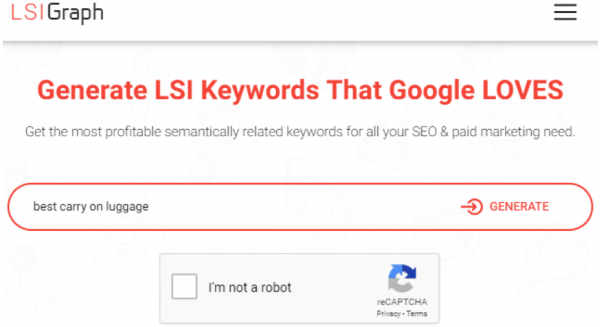
Build a Content Machine
Your content must deliver the goods. It has to be better than your rivals and it needs to be extremely valuable.
To do this, you must hire multiple writers that know how to produce high-quality content.
This should be their sole responsibility. You may also consider adding an editor to your team to manage all of your in-house content.
Here’s what a job description should look like when you do post the advertisement on a website such as ProBlogger.
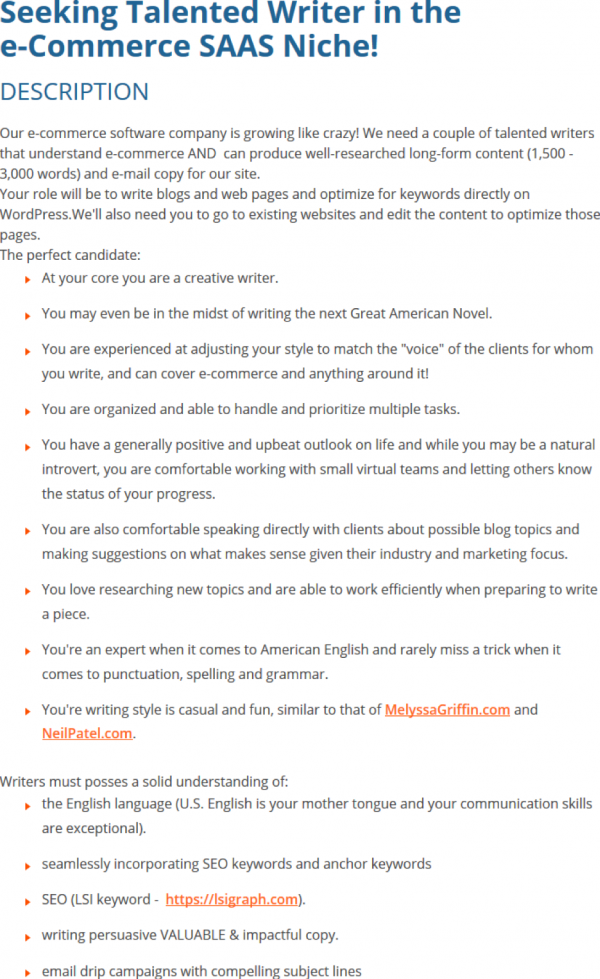
Good content doesn’t come cheap, though. Be prepared to pay $0.15 to $0.25 per word.
Conclusion
To sum up, getting ranked with no spend means you should be looking to creating value and sticking to white-hat SEO techniques. This means improving your user experience (site speed) and chasing high-quality backlinks from authoritative websites.
The more value you create for your audience, the more shares, link and Google love you’ll receive. Focus on doing the right thing and good things will happen.
The next step is to put together a strong content marketing team and a strong outreach team. The two can go hand in hand. Find good link opportunities, produce amazing content and you’re well on your way to ranking success.
For more tips on how to boost your ecommerce business, including SEO and marketing hacks, subscribe to our blog above!
